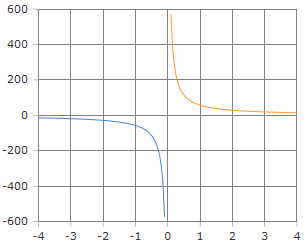Cot - Calculate Cotangent
Online calculator for calculating the cotangent of an angle
Cotangent Calculator
Instructions
Enter the angle whose cotangent you want to calculate, select the unit of measure (degrees or radians) and click Calculate.
Cotangent - Overview
Value Range
The angle is given in degrees (full circle = 360°) or radians (full circle = 2·π).
Note: The cotangent is undefined at 0°, 180°, 360° (or 0, π, 2π in radians) where sin(α) = 0.

Cotangent, scale in degrees
Definition in Triangle
The cotangent is the reciprocal of the tangent. It corresponds to the ratio of the adjacent side to the opposite side in a right triangle.
\(\displaystyle \cot(\alpha) = \frac{\text{Adjacent}}{\text{Opposite}} = \frac{b}{a} = \frac{1}{\tan(\alpha)} \)

Important Values
- \( \cot(30°) = \sqrt{3} \approx 1.732 \)
- \( \cot(45°) = 1 \)
- \( \cot(60°) = \frac{1}{\sqrt{3}} \approx 0.577 \)
- \( \cot(90°) = 0 \)
- \( \cot(0°) = \) undefined (∞)
- \( \cot(180°) = \) undefined (∞)
|
|
Description of the Cotangent
Fundamentals
The cotangent is one of the six basic trigonometric functions. It is the reciprocal of the tangent function. In a right triangle, the cotangent of an angle α is the ratio of the adjacent side to the opposite side.
Definition:
\(\displaystyle \cot(\alpha) = \frac{\text{Adjacent}}{\text{Opposite}} = \frac{b}{a} \)
\(\displaystyle \cot(\alpha) = \frac{1}{\tan(\alpha)} = \frac{\cos(\alpha)}{\sin(\alpha)} \)
Properties
The cotangent function has several important properties:
- Periodic: cot(α + 180°) = cot(α)
- Odd function: cot(-α) = -cot(α)
- Undefined: At 0°, ±180°, ±360°, ... (where sin(α) = 0)
- Range: All real numbers (-∞, +∞)
- Domain: All real numbers except multiples of 180° (or π)
Relationship to Other Functions
The cotangent is related to other trigonometric functions:
\(\displaystyle \cot(\alpha) = \frac{1}{\tan(\alpha)} \)
\(\displaystyle \cot(\alpha) = \frac{\cos(\alpha)}{\sin(\alpha)} \)
\(\displaystyle 1 + \cot^2(\alpha) = \csc^2(\alpha) \)
Detailed Examples
Example 1: Calculate Cotangent
Given:
A right triangle with:
- Adjacent side (to α): \( b = 4 \text{ cm} \)
- Opposite side: \( a = 3 \text{ cm} \)
Calculation:
\(\displaystyle \cot(\alpha) = \frac{4}{3} \approx 1.333 \)
To find the angle: \( \alpha = \text{arccot}(1.333) \approx 36.87° \)
Example 2: Known Angles
Important cotangent values:
| \( \cot(30°) \) | = | \( \sqrt{3} \approx 1.732 \) |
| \( \cot(45°) \) | = | 1 |
| \( \cot(60°) \) | = | \( \frac{1}{\sqrt{3}} \approx 0.577 \) |
| \( \cot(90°) \) | = | 0 |
| \( \cot(120°) \) | = | \( -\frac{1}{\sqrt{3}} \approx -0.577 \) |
| \( \cot(135°) \) | = | -1 |
Example 3: Using Tangent
Task:
If \( \tan(\alpha) = 2 \), what is \( \cot(\alpha) \)?
Solution:
\(\displaystyle \cot(\alpha) = \frac{1}{\tan(\alpha)} = \frac{1}{2} = 0.5 \)
Conversion
From degrees to radians:
\(\displaystyle \text{Radians} = \frac{\text{Degrees} \cdot \pi}{180°} \)
Mathematical Properties
- Period: 180° or π (radians)
- Symmetry: Odd function: cot(-α) = -cot(α)
- Asymptotes: Vertical at 0°, ±180°, ±360°, ...
- Zeros: At 90° + n·180° (n integer)
- Reciprocal: cot(α) = 1/tan(α)
- Pythagorean identity: 1 + cot²(α) = csc²(α)
- Addition formula:
- \( \cot(\alpha + \beta) = \frac{\cot\alpha\cot\beta - 1}{\cot\alpha + \cot\beta} \)
Practical Applications
- Engineering: Slope and gradient calculations
- Physics: Wave mechanics and oscillations
- Surveying: Angle and distance measurements
- Navigation: Course and bearing calculations
- Architecture: Roof pitch and ramp angles
- Astronomy: Celestial coordinate calculations
- Computer graphics: Perspective projections
- Signal processing: Phase relationships
Important Note
The cotangent function is undefined at angles where the sine equals zero (0°, ±180°, ±360°, ... or 0, ±π, ±2π, ...). At these points, the function approaches positive or negative infinity. The cotangent is the reciprocal of the tangent: cot(α) = 1/tan(α) = cos(α)/sin(α). The function has a period of 180° (or π radians), meaning cot(α + 180°) = cot(α). Unlike sine and cosine, the cotangent can take any real value from -∞ to +∞, making it useful in calculations involving slopes and gradients.
|
|